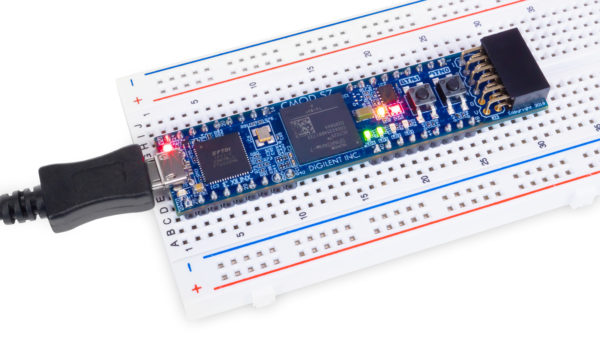Earlier in the year we announced the release of the Arty S7-50, featuring Xilinx’s cost optimized Spartan-7 FPGAs, as a first-of-its-kind development board on the market. A few months later, we released a variant, the Arty S7-25 for users who wanted additional savings by using the smaller XC7S25-CSGA324, or Spartan-7-25, FPGA.
Now we are excited to announce the smallest form factor Spartan-7 development board on the market…the Cmod S7-25! See below for an actual size comparison to the Arty S7.

The Cmod S7-25 is the latest member to our Cmod product line. Cmod (or Carrier Modules) were designed to speed up prototyping for design engineers. Unlike our standard systems boards where all of the FPGA I/O is designed into a function (think 16 switches + 16 LED= 32 I/O tied up on the Basys 3 board), a Cmod allows the user to choose what I/O functionality they would like to have. This is ideal for teaching students, because a teacher can emphasize the hardware design by having students physically wire up external hardware to their FPGA (instead of having it already done for them). It can be configured for digital logic circuits, Micoblaze designs, or for addition of peripherals. It is also useful for prototyping ASIC designs. The compact size and 100 mil spaced through-hole pins make it possible to load the Cmod into standard sockets or breadboards.

The Cmod S7-25 features the same FPGA that is on the Arty S7-25. With the addition of 4 LEDs, 2 push buttons, RGB LED and a Pmod port, the Cmod S7 is the most suited for teaching and breadboarding out of the Cmod family.

The Xilinx Spartan-7 FPGA (XC7S25-1CSGA225C) features the following:
-
3,650 slices containing four 6-input LUTs and 8 flip-flops
-
1,620 Kbits of fast block RAM
-
3 clock management tiles, each with a phase-locked loop and mixed-mode clock manager
-
80 DSP slices
-
Internal clock speeds exceeding 450 MHz
-
On-chip analog-to-digital converter (XADC)
-
Programmable over JTAG and Quad-SPI Flash
Note, the Cmod S7 is unique among Digilent Cmods in its pin form factor. The Cmod S7 is similar to the 48-pin DIP form factor of the Cmod A7, but only has 36 pins populated.

The removal of these pins allowed the placement of the FPGA, but also helps with the removal and insertion of the Cmod into breadboards.

Between its hardware and versatile form factor, this board is an ideal choice both for education and personal use. Check it out on our store!


Is there a migration guide for moving from Cmod A7 to the S7?
Thank you for your question! For the quickest response to your technical questions, we encourage you to post your inquiry on our active Digilent Forum. Our team of engineers actively monitors the forum and strives to provide timely assistance. You can find the forum here: https://forum.digilent.com/